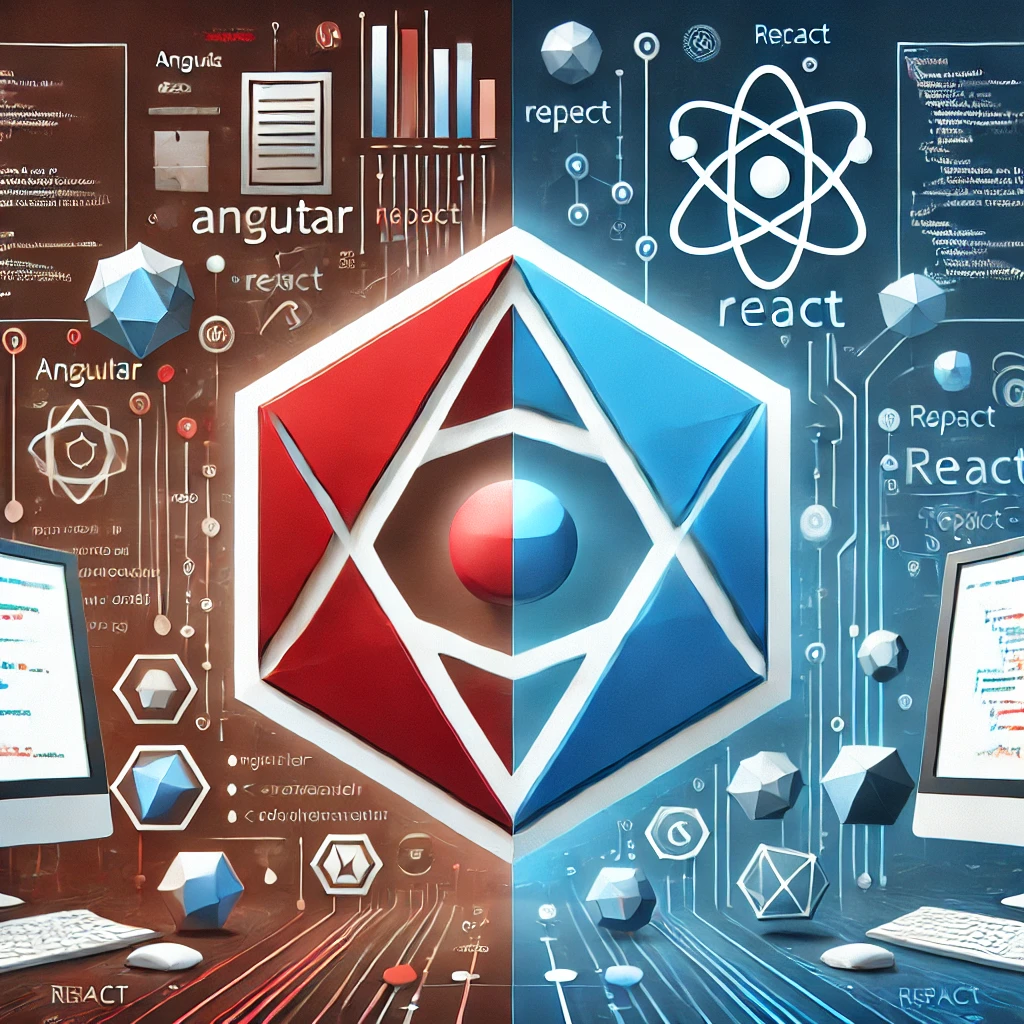"Angular vs. React: A Deep Dive into the Front-End Frameworks Shaping the Web"
Overview of Angular and React
Angular, introduced by Google in 2010 as AngularJS and later re-envisioned as Angular 2+ with TypeScript support, is a full-featured front-end framework. Known for its strong MVC (Model-View-Controller) architecture, Angular provides a structured environment suitable for enterprise applications. Its modular setup, including components, services, and modules, streamlines the organization and separation of concerns within applications. Angular’s CLI (Command Line Interface) accelerates development with powerful tools for code scaffolding, testing, and production builds.
React, created by Facebook in 2013, brings a different approach with a focus on building dynamic UIs. React is a JavaScript library rather than a full framework, with a modular architecture that gives developers the freedom to choose supporting libraries for routing, state management, and more. The Virtual DOM enables React to optimize rendering, resulting in enhanced performance and responsiveness, particularly beneficial for UIs with frequent updates. React’s component-based design promotes reusability and flexibility, making it a go-to for applications requiring a fast, iterative development approach.
Learning Curve
Angular has a more structured and opinionated framework that requires knowledge of TypeScript, RxJS (for handling asynchronous events), and Angular-specific concepts like dependency injection and decorators. Its component-based structure and reliance on observables enable handling complex data flows but add complexity for beginners. Angular’s vast library of pre-built modules reduces the need for external libraries, but it requires a solid understanding of its architecture to fully leverage its capabilities in large-scale applications.
React offers a quicker entry into UI development, with a learning curve that scales with project complexity. Basic components can be created using JavaScript and JSX, allowing developers to get started quickly. React’s approach to unidirectional data flow simplifies debugging and state management in simpler applications. For larger applications, however, learning libraries like Redux (for state management) or React Router can add additional learning requirements. The modular nature of React enables gradual learning, allowing developers to integrate advanced features incrementally.
Performance
Angular’s use of two-way data binding simplifies the synchronization of UI elements with model data, but it can lead to performance issues in complex applications due to the frequent checks required in the change detection cycle. To address this, Angular introduced Angular Ivy as its new rendering engine in Angular 9, which offers tree-shaking to reduce bundle sizes and optimizes components for faster load times. Angular’s AOT (Ahead-of-Time) compilation further enhances performance by converting TypeScript into optimized JavaScript before runtime, making it ideal for large-scale applications where efficiency is crucial.
React relies on a Virtual DOM that updates only the parts of the UI that have changed, resulting in highly efficient rendering. This makes React particularly suited to dynamic UIs with frequent updates, such as interactive dashboards or social media feeds. Additionally, React’s one-way data binding and immutability concepts simplify the management of state changes, minimizing unexpected UI behavior. React’s concurrent mode, an experimental feature, introduces advanced optimizations for complex applications, improving responsiveness and load time in heavy-use applications.

Community and Ecosystem
Both Angular and React benefit from large, active communities that continuously contribute libraries, plugins, and resources, but each ecosystem has its distinct characteristics.
Angular offers a robust, built-in toolset and ecosystem that eliminates the need for many external libraries, resulting in consistent project architectures. Angular Material, a popular UI library, provides a suite of reusable, accessible UI components that align with Google’s Material Design principles, ensuring a visually cohesive experience across applications. Angular Universal enables server-side rendering, and the Angular CLI offers built-in support for testing and deployment, enhancing the developer experience for large projects.
React benefits from a vast, flexible ecosystem, including popular libraries like Redux (for state management) and React Router (for navigation). React’s popularity has also spurred the growth of complementary frameworks such as Next.js (for server-side rendering and static site generation), expanding its utility beyond front-end development. React’s modularity allows developers to pick and choose libraries based on their project requirements, making it suitable for everything from quick prototypes to production-grade applications. Additionally, a wealth of design libraries, such as Material-UI and Ant Design, provide customizable, ready-to-use components.
Use Cases
The choice between Angular and React often depends on the specific requirements and objectives of your project:
- Angular: Ideal for applications requiring a well-structured, opinionated architecture, such as complex enterprise systems, large-scale e-commerce platforms, or internal tools. Angular’s extensive toolset and predefined patterns make it particularly suitable for projects with multiple developers or where long-term maintainability is a priority. Additionally, Angular’s capabilities in form handling, dependency injection, and real-time data updates make it a strong candidate for data-heavy applications.
- React: Suitable for projects where flexibility, customization, and rapid prototyping are essential. React’s component reusability and Virtual DOM enable the development of high-performance, interactive UIs with ease, making it a popular choice for social networks, media platforms, and interactive dashboards. Furthermore, its integration with React Native allows developers to create mobile applications with a shared codebase, making React a powerful choice for projects requiring cross-platform support.
Development Speed
Angular’s CLI and opinionated framework reduce the need to choose between various tools and libraries, speeding up the initial setup and providing consistency across projects. With built-in support for routing, form validation, and HTTP client services, Angular is ideal for development teams seeking a structured environment with minimal configuration needs. While Angular’s complexity may initially slow down development, its organized structure and comprehensive documentation enable faster iteration once the team is familiar with its architecture.
React allows for rapid development due to its simplicity and flexibility. Developers can begin building with minimal setup, adding complexity as needed through third-party libraries. Its component-based architecture promotes reusability, enabling developers to create a library of UI components that can be repurposed across different parts of the application. React’s integration with tools like Storybook and component libraries like Material-UI speeds up UI development, making it suitable for agile teams prioritizing iterative development and fast prototyping.
Pros and Cons
Here’s a more detailed comparison of Angular and React’s strengths and limitations:
| Feature | Angular | React |
|---|---|---|
| Pros | - Comprehensive framework with built-in tools - TypeScript support for better type-checking - Strong support for large-scale applications - Angular CLI for streamlined project management |
- Virtual DOM for efficient updates - Flexibility in choosing libraries and tools - Strong component reusability - Large ecosystem and extensive community support |
| Cons | - Steep learning curve, especially for beginners - Heavyweight, potentially slowing load times - Requires understanding of TypeScript and RxJS - Opinionated, reducing flexibility for custom setups |
- Requires additional libraries for full functionality - Unopinionated, leading to more decisions on project setup - Can grow complex in large applications without conventions - Frequent updates may lead to compatibility challenges |
Conclusion: Angular or React?
Both Angular and React are powerful tools, each well-suited to specific types of applications. Angular is ideal for large-scale, structured projects with complex requirements, providing a comprehensive toolkit and opinionated framework that supports team collaboration and long-term maintenance. React, on the other hand, is optimal for projects prioritizing speed, flexibility, and iterative development, particularly where a highly interactive UI is crucial. Ultimately, the decision comes down to your project’s unique needs, your team’s familiarity with each technology, and your long-term goals.
For developers seeking guidance on mastering Angular, React, and other full-stack skills, ApnaGuru offers a comprehensive Full Stack Development Course designed to bridge the gap between foundational knowledge and hands-on project experience. Our experienced mentors and real-world projects ensure that you not only learn but apply your knowledge effectively. Join ApnaGuru’s supportive community and gain the skills needed to thrive in today’s competitive tech industry. Start your journey with us by visiting ApnaGuru's Full Stack Development Course and take the first step toward becoming a versatile, job-ready developer.
